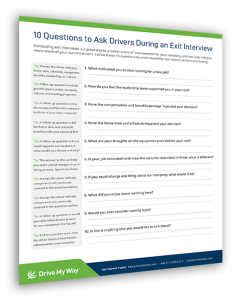
In the fast-paced world of the trucking industry, driver happiness can either be your company’s greatest asset or its biggest roadblock. At Drive My Way, we recognize the crucial role that driver satisfaction plays in keeping your business running smoothly. That’s why we put our expertise to work and conducted the 2023 CDL Truck Driver Job Happiness Report, reaching out to over 500 CDL drivers nationwide to gain a deeper understanding of what makes them happy in their careers and lives.
Our recently released report is brimming with fascinating trends and key findings that every trucking company should have on their radar. By taking these insights to heart and proactively addressing them, you can boost driver retention, enhance your recruitment strategies, and keep your company moving forward in this competitive industry. So, buckle up and get ready to explore the world of driver happiness – your company’s success depends on it.
Overall Driver Happiness Has Declined
One of the most significant findings from our report is that overall driver happiness has dropped slightly since 2019. In 2023, only 51% of surveyed drivers reported being happy with their job, compared to 54% in 2019. This decline in happiness was more pronounced among younger and less experienced drivers, with those having less than eight years of experience reporting the biggest drop in satisfaction.
This trend highlights the need for trucking companies to focus on driver satisfaction, particularly among newer and younger drivers.
New Drivers Need More Support
Our report also revealed that drivers with 1-2 years of experience reported significantly lower happiness levels than any other segment, with only 44% saying they were happy in their current role. Moreover, three out of four drivers in this group reported actively looking for other jobs. The primary reason for this dissatisfaction? A lack of information and support.
Only 40% of drivers with 1-2 years of experience felt they had the information they needed to be successful in their roles. This finding underscores the importance of providing comprehensive training, ongoing support, and clear communication to new drivers, even after their initial orientation period. By investing in the success of new drivers, companies can improve retention and build a stronger, more loyal workforce.
Happy Drivers Are More Likely to Stay and Refer Others
Our report confirmed that driver happiness is closely linked to retention and referrals. Happy drivers are three times more likely to refer others to their employer than unhappy drivers, and they are also more likely to express a desire to stay with their company for the long term.
However, our findings also revealed that even happy drivers are nearly twice as likely to look for a new job compared to 2019. This trend suggests that in today’s competitive job market, simply keeping drivers happy may not be enough to guarantee retention. Companies must go above and beyond to demonstrate their commitment to driver satisfaction and well-being, offering competitive compensation, benefits, and a positive work environment.
Communication and Listening Are Key
When asked about the one change their current employer could make to increase job happiness, drivers highlighted several factors, including better compensation, improved benefits, and more consistent work schedules. However, one factor stood out as particularly important for certain groups of drivers: better communication and listening from management.
Our report found that female drivers and those with less than two years of experience were twice as likely to cite better communication and listening as the key to improving their job happiness. This finding emphasizes the need for trucking companies to prioritize open, transparent communication with their drivers, especially those who may be more vulnerable to dissatisfaction and turnover.
Adapting to Driver Preferences in Recruitment
In addition to insights on driver happiness, our report also shed light on how drivers prefer to learn about new job opportunities and communicate with recruiters. The top three sources for job information were general job boards (46%), online searches (42%), and word-of-mouth referrals from other drivers (33%).
When it comes to communicating with recruiters, drivers expressed a preference for communication via email (32%), followed by phone (32%), face-to-face interactions (19%), and SMS (16%). These preferences varied somewhat based on factors such as age, gender, and years of experience, highlighting the importance of tailoring recruitment strategies to different driver segments.
By understanding and adapting to these communication preferences, trucking companies can more effectively reach and engage potential hires, ultimately improving their recruitment efforts and attracting top talent to their organization.
The 2023 CDL Truck Driver Job Happiness Report is your roadmap to navigating the complex world of driver satisfaction. By diving into these valuable insights and taking action to address the factors that contribute to driver happiness, you can create a work environment that not only supports your drivers but also fuels your company’s success. Imagine a future where your drivers are more content, your retention rates are sky-high, and your recruitment efforts are the envy of the industry. You can read the full report here: Full Report
At Drive My Way, we’re not just along for the ride – we’re here to help you steer your company towards a brighter future. By keeping our finger on the pulse of CDL drivers’ evolving needs and preferences, we work hand in hand with trucking companies like yours to build a stronger, more resilient industry that benefits everyone involved.


 At this point, the trucking shortage has become the normal state of things. It’s widely understood that the demand for truck drivers is much higher than the supply of drivers looking for jobs. Because of this, trucking companies are doing whatever they can to keep current drivers happy and bring new ones onboard. This includes pay increases, newer trucks and equipment, increased home time, and more.
At this point, the trucking shortage has become the normal state of things. It’s widely understood that the demand for truck drivers is much higher than the supply of drivers looking for jobs. Because of this, trucking companies are doing whatever they can to keep current drivers happy and bring new ones onboard. This includes pay increases, newer trucks and equipment, increased home time, and more.


